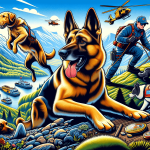Dog training hand signals is a wise choice for some types of dogs. Because most of us communicate verbally, we assume its best, to use verbal commands with our dogs. However, hand signals make the training much more effective. No matter if you want to show your dog where is the limit of the area of the wireless fence or when he should give a voice or be quiet.
You can use hand gestures to cue desired action in your dog these are known as dog training hand signals. There are a number of reasons to choose hand signals over verbal commands:
1. When working with hunting dogs, they are usually a distance away. If taught hand signals, the handler can communicate to the dog what the plan of action is.
I see this every time we work our hunting dogs, and it always amazes me.
2. Excited dogs do not listen very well. However, they do respond to what they see.
3. A dog may ignore a verbal command but respond to a hand signal.
4. Dogs are not always nearby. If your dog runs off, if you are running an agility course, or if you are hunting in the field, your dog may not hear your verbal command.
They are more likely to see your hand gesture.
5. Hand signals can be taught along with verbal commands. Using both hand gestures and verbal commands at the beginning of your dogs training helps reinforce your command.
6. The use of physical signals seems more impressive to others. Most people are amazed when owners can control their dogs without saying a word.
7. Dogs focus more on you. If your dog knows he has to watch you for a command, he will be less distracted by everything else and will be easier to train.
8. Obviously, if you have a dog that has a hearing impairment then using this method, offers a way to train without words.
Common Dog Training Hand Signals

Like verbal commands, you have complete control over the dog using signals as cues. The only rule is once you have started using a particular signal for a command you should remain consistent.
To give you some ideas of common hand signals, here are a few used by other trainers.
1. Stay.
Hold your hand out towards you dog as if telling him to stop.
The palm should face his nose.
Your fingertips should point upwards.
2. Down.
Lower your hand or point finger towards the ground.
Some trainers exaggerate the gesture by starting with their hand held higher than normal.
3. Come.
Hold your left arm straight so it is parallel to the floor.
Slowly, move your arm in front of your body and touch your right shoulder with your left hand.
The gesture only needs to be slow at first.
Once the dog learns it you can move faster.
4. Sit.
Hold your arm at your side so your hand is pointing down.
Raise your arm so your hand moves in front of your dogs face and over his head.
If you are holding a treat, his nose and eyes will follow your gesture. He will automatically go into a sitting position.
Remember these are just some of the dog training hand signals you can use. Try to choose hand signals you are comfortable doing and use them consistently while training your dog.













